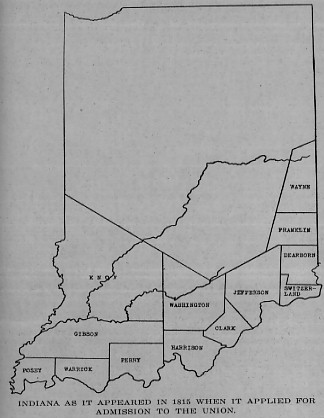The Judicial Structure in Indiana: Territorial Period 1800 - 1816

Types of courts: Under the new law, the General or Supreme Court was the highest territorial court. Three judges presided over this court which was held twice annually in March and September. The judges heard appeals, issued writs, and constituted the court of last resort. This court had jurisdiction over all civil and criminal cases for the territory.
The Circuit Court was the mid-level court for the territory and its counties. One or more of the three Territorial Judges met annually in October in each county, and more often, if necessary, for jail deliveries. This court heard appeals, pleas, and probate cases. Its jurisdiction was over civil and criminal cases for each county.
The Quarter Sessions, or Quarter Sessions of the Peace, were the highest county/local courts. This court had three justices who met four times annually in February, May, August, and November, also holding special sessions when necessary. The jurisdiction was over criminal cases for the county.
The Common Pleas were of an equivalent stature with the Quarter Sessions. The same three justices met four times annually in February, May, August, and November. The jurisdiction here was over civil cases for the county.
Justices or Justice of the Peace or Township courts had county or local jurisdiction. In such courts, one justice held sessions only when necessary. The jurisdiction was over civil cases for any debt under $5.00.
Orphan's courts were also locally based. The three Quarter Sessions/Common Pleas justices presided. This court also met only when necessary and its jurisdiction was over civil cases.
Coroner's courts too were local. A Coroner and jury met only when necessary. The jurisdiction was over civil cases involving death, the purpose being to determine how and/or where a death occurred.
Probate courts were county and local. A Probate Judge for each county held court four times annually in February, May, August, and November, and more often if necessary. The jurisdiction was over civil cases concerning last wills and testaments. The judge would either witness the documents or make some determination on property.
Chancery courts were also local. A Chancery Judge for each county held court twice annually in February and August. The jurisdiction was over civil cases.
On August 24, 1805, the first Territorial legislature enacted a general consolidation of the county courts. The Circuit and Supreme courts remained the same, but the Quarter Sessions, Common Pleas, Probate, and Orphan's courts were consolidated into one county court under the historic name of Common Pleas. Endless litigation necessitated this change, and it was hoped that the improved court system could keep pace with the work. To replace the score or so of justices in each county, the governor appointed three judges only. These judges were required to hold court six times annually instead of four.
The Act of February 7, 1814, reorganized the Courts of Justice for the Territory into three districts with a circuit court established in each. The courts consisted of one of the Territorial Judges, as president, and three associates to have jurisdiction in all cases, at law and equity; these common law courts now had chancery powers. This change, as in 1805, was prompted by the continual dissatisfaction throughout the territory over the courts' inability to keep pace with the constant litigation. The First Circuit was comprised of the counties of Knox, Gibson, and Warrick, from which Posey County would later be organized.
